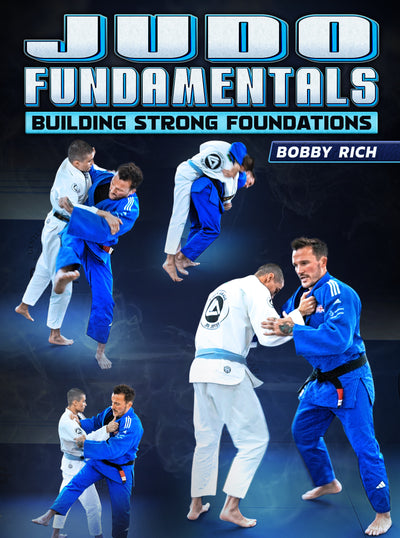Ippon Seoi Nage Tips With Travis Stevens
Seoi Nage (meaning shoulder throw in English) is one of the core forty throws in Jigoro Kano’s Gokyo of Kodokan Judo. It’s a part of the Dai Ikkyo (first group) of techniques that all Judoka learn and therefore is a staple of Judo’s tachi waza (standing techniques). Seoi Nage is a very powerful throw with great transitional options for ne waza (ground techniques) and as such is a powerful addition to your arsenal of takedowns.
Who better to show us his own variation of Seoi Nage than Olympic Silver medalist Judoka and Black Belt under John Danaher Travis Stevens?
We will first look at the orthodox technique of Seoi Nage to give us the foundation to understand Travis’ variation.
Traditionally Seoi Nage is executed from an orthodox sleeve and lapel grip with kuzushi (breaking balance) attained by pulling your opponent forward onto the balls of their feet or forward and to their right. This pulling is done using both sleeve and lapel being drawn towards you and up while the lapel side foot moves to it’s opposite side as you rotate so that your back is against you opponents chest.
Update your Judo with Travis Stevens! Click Learn More!
Your lapel grip arm’s elbow moves deeply through to the opposite side of your opponents body and your sleeve grip maintains tight control of your opponents arm close in to your body.
As you step through to gain back to chest contact with your opponent it is important that you maintain your own weight in the balls of your feet so that it’s easier for you to sink your hips down underneath your opponents center of gravity.
A common way of thinking about this is to make sure your belt line is below your opponents belt line. A second reason it’s good to slightly float your heels and stay on the balls of your feet is that if while stepping through for the throw your weight is in your heels you will tend to lose your balance backward and be vulnerable to counter throws from your opponent.
Now your opponent is loaded onto your back and their balance is broken we are in the perfect position to finish Seoi Nage. We bring both arms and hands through the throw with a circular motion pulling our opponent through the throw to complete our shoulder throw. One important point to note here is working on this with a partner is to pull them upwards as they land to reduce the impact on your partner. This also ingrains the positive habit of maintaining control of your opponents arm for transitions to ne waza (ground techniques).
The first difference that Travis shows from an orthodox Seoi Nage is the grip on the sleeve. The orthodox sleeve grip is taken underneath the sleeve and is something our opponent is very aware of and very cautious to defend. With this variation of Seoi Nage Travis is taking a pistol grip on the top of his opponents sleeve, which is helpful for expediency. Sometimes a top grip is easier to take because our hand doesn’t have to pass our opponents hand and can therefore go straight to the sleeve, especially if our opponent is coming upwards for our lapel.
From this sleeve grip Travis can hold his opponents arm down and away from his own body so that he now has the space to rotate his hips into the throw.
After securing the sleeve Travis now moves to the lapel, again with an important difference to an orthodox grip. The orthodox grip for Ippon Seoi Nage is to have a dominant inside grip on our opponents lapel, but the difficulty with this is our opponent is aware the inside lapel grip is dominant and so will be diligent in defending against this grip while also seeking their own.
The variation Travis is showing allows for his opponent to have an inside grip on his lapel as to execute this variation Travis is reaching over their gripping arm to an outside lapel grip. This detail alone is huge for those of us frustrated by our opponents tight kumi kata game!
After securing the lapel grip over the top of his opponents arm Travis wants the same foot forward as the side he has taken a sleeve grip with and his body to be at an angle rather than square on as is taught in the foundations of the technique. The reason for this angle is that Travis is going to shoot one of his legs in the gap between his opponents legs and this angle gives him space to do that.
Now Travis has got his initial stance he begins the process of kuzushi (breaking balance) and takes his elbow towards the ceiling on the arm that’s gripping his opponents lapel. This takes his opponents balance up onto the balls of their heels.
Careful not to pull your opponent forward here as they will likely pull backwards in reaction to this.
After pulling upwards Travis rotates and switches his feet so that what was his lead foot goes through the gap in his opponents legs into a lunge position with his foot directly behind his opponents right foot.
At this point Travis’ free hand comes up to take a double grip on his opponents lapel and while pulling down he steps backwards towards his rear heel and lifts his opponent onto his back.
From here Travis rotates his shoulders for a big shoulder throw and retains control of his opponents arm for a strong transition to ne waza, having already passed his opponents guard while standing.

For more game changing details from Olympian Judoka see ‘The Judo Academy’ by Jimmy Pedro and Travis Stevens here!



